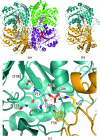Structure of the cystathionine γ-synthase MetB from Mycobacterium ulcerans
- PMID: 21904066
- PMCID: PMC3169418
- DOI: 10.1107/S1744309111029575
Structure of the cystathionine γ-synthase MetB from Mycobacterium ulcerans
Abstract
Cystathionine γ-synthase (CGS) is a transulfurication enzyme that catalyzes the first specific step in L-methionine biosynthesis by the reaction of O(4)-succinyl-L-homoserine and L-cysteine to produce L-cystathionine and succinate. Controlling the first step in L-methionine biosythesis, CGS is an excellent potential drug target. Mycobacterium ulcerans is a slow-growing mycobacterium that is the third most common form of mycobacterial infection, mainly infecting people in Africa, Australia and Southeast Asia. Infected patients display a variety of skin ailments ranging from indolent non-ulcerated lesions as well as ulcerated lesions. Here, the crystal structure of CGS from M. ulcerans covalently linked to the cofactor pyridoxal phosphate (PLP) is reported at 1.9 Å resolution. A second structure contains PLP as well as a highly ordered HEPES molecule in the active site acting as a pseudo-ligand. These results present the first structure of a CGS from a mycobacterium and allow comparison with other CGS enzymes. This is also the first structure reported from the pathogen M. ulcerans.
Figures




Similar articles
-
Crystal structure of Escherichia coli cystathionine gamma-synthase at 1.5 A resolution.EMBO J. 1998 Dec 1;17(23):6827-38. doi: 10.1093/emboj/17.23.6827. EMBO J. 1998. PMID: 9843488 Free PMC article.
-
The crystal structure of cystathionine gamma-synthase from Nicotiana tabacum reveals its substrate and reaction specificity.J Mol Biol. 1999 Jul 30;290(5):983-96. doi: 10.1006/jmbi.1999.2935. J Mol Biol. 1999. PMID: 10438597
-
Structural Insights into Substrate Specificity of Cystathionine γ-Synthase from Corynebacterium glutamicum.J Agric Food Chem. 2017 Jul 26;65(29):6002-6008. doi: 10.1021/acs.jafc.7b02391. Epub 2017 Jul 13. J Agric Food Chem. 2017. PMID: 28675039
-
The enzymes of the transsulfuration pathways: active-site characterizations.Biochim Biophys Acta. 2011 Nov;1814(11):1511-7. doi: 10.1016/j.bbapap.2011.03.006. Epub 2011 Mar 22. Biochim Biophys Acta. 2011. PMID: 21435402 Review.
-
The enzymology of cystathionine biosynthesis: strategies for the control of substrate and reaction specificity.Arch Biochem Biophys. 2005 Jan 1;433(1):166-75. doi: 10.1016/j.abb.2004.08.024. Arch Biochem Biophys. 2005. PMID: 15581575 Review.
Cited by
-
Expression, crystallization and preliminary X-ray crystallographic analysis of cystathionine γ-synthase (XometB) from Xanthomonas oryzae pv. oryzae.Acta Crystallogr Sect F Struct Biol Cryst Commun. 2012 Dec 1;68(Pt 12):1515-7. doi: 10.1107/S1744309112042819. Epub 2012 Nov 14. Acta Crystallogr Sect F Struct Biol Cryst Commun. 2012. PMID: 23192036 Free PMC article.
-
Biocatalytic synthesis of α-amino ketones.Synlett. 2019 Jul;30(11):1269-1274. doi: 10.1055/s-0037-1611755. Epub 2019 Mar 19. Synlett. 2019. PMID: 31354189 Free PMC article.
-
Unlocking Opportunities for Mycobacterium leprae and Mycobacterium ulcerans.ACS Infect Dis. 2024 Feb 9;10(2):251-269. doi: 10.1021/acsinfecdis.3c00371. Epub 2024 Jan 31. ACS Infect Dis. 2024. PMID: 38295025 Free PMC article. Review.
-
Catalytic specificity of the Lactobacillus plantarum cystathionine γ-lyase presumed by the crystallographic analysis.Sci Rep. 2020 Sep 10;10(1):14886. doi: 10.1038/s41598-020-71756-7. Sci Rep. 2020. PMID: 32913258 Free PMC article.
-
Expression, crystallization and preliminary X-ray crystallographic analysis of cystathionine β-lyase from Acinetobacter baumannii OXA-23.Acta Crystallogr F Struct Biol Commun. 2014 Oct;70(Pt 10):1368-71. doi: 10.1107/S2053230X14017981. Epub 2014 Sep 25. Acta Crystallogr F Struct Biol Commun. 2014. PMID: 25286941 Free PMC article.
References
-
- Alexandrov, A., Dutta, K. & Pascal, S. M. (2001). Biotechniques, 30, 1194–1198. - PubMed
-
- Alexandrov, A., Vignali, M., LaCount, D. J., Quartley, E., de Vries, C., De Rosa, D., Babulski, J., Mitchell, S. F., Schoenfeld, L. W., Fields, S., Hol, W. G., Dumont, M. E., Phizicky, E. M. & Grayhack, E. J. (2004). Mol. Cell. Proteomics, 3, 934–938. - PubMed
-
- Amadasi, A., Bertoldi, M., Contestabile, R., Bettati, S., Cellini, B., di Salvo, M. L., Borri-Voltattorni, C., Bossa, F. & Mozzarelli, A. (2007). Curr. Med. Chem. 14, 1291–1324. - PubMed
Publication types
MeSH terms
Substances
Associated data
- Actions
- Actions
Grants and funding
LinkOut - more resources
Full Text Sources
Research Materials

